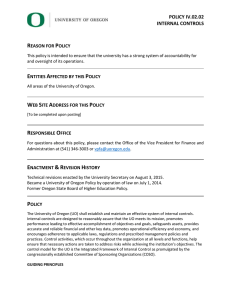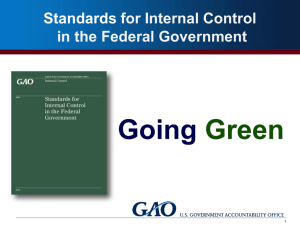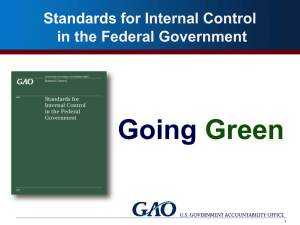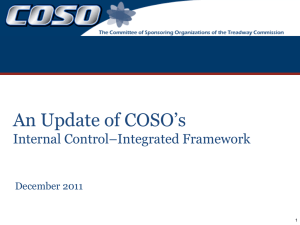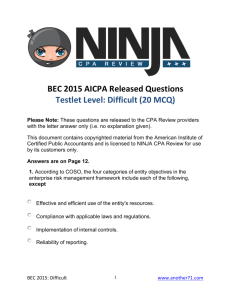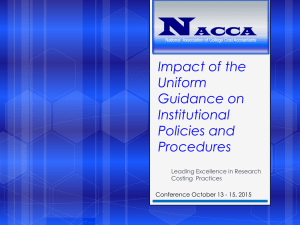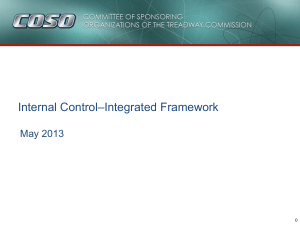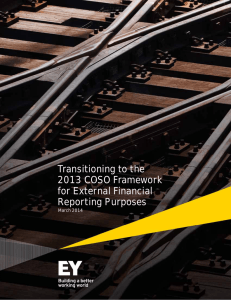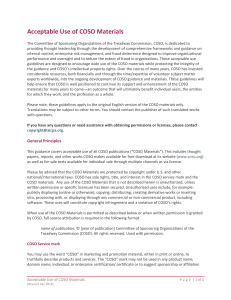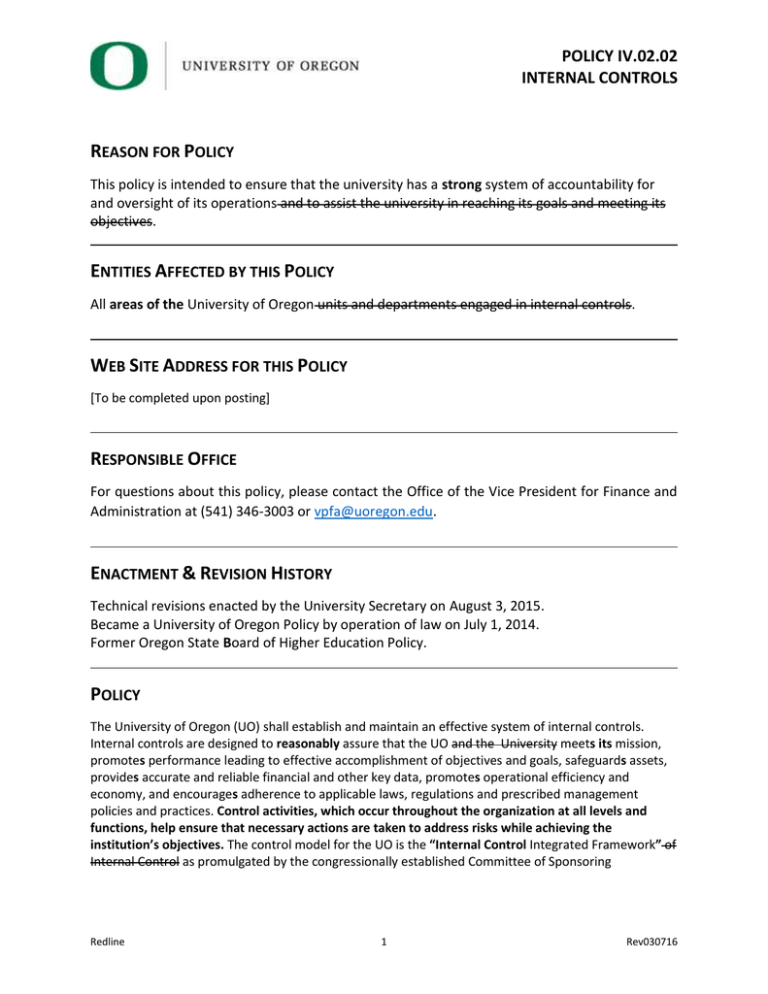
POLICY IV.02.02
INTERNAL CONTROLS
REASON FOR POLICY
This policy is intended to ensure that the university has a strong system of accountability for
and oversight of its operations and to assist the university in reaching its goals and meeting its
objectives.
ENTITIES AFFECTED BY THIS POLICY
All areas of the University of Oregon units and departments engaged in internal controls.
WEB SITE ADDRESS FOR THIS POLICY
[To be completed upon posting]
RESPONSIBLE OFFICE
For questions about this policy, please contact the Office of the Vice President for Finance and
Administration at (541) 346-3003 or vpfa@uoregon.edu.
ENACTMENT & REVISION HISTORY
Technical revisions enacted by the University Secretary on August 3, 2015.
Became a University of Oregon Policy by operation of law on July 1, 2014.
Former Oregon State Board of Higher Education Policy.
POLICY
The University of Oregon (UO) shall establish and maintain an effective system of internal controls.
Internal controls are designed to reasonably assure that the UO and the University meets its mission,
promotes performance leading to effective accomplishment of objectives and goals, safeguards assets,
provides accurate and reliable financial and other key data, promotes operational efficiency and
economy, and encourages adherence to applicable laws, regulations and prescribed management
policies and practices. Control activities, which occur throughout the organization at all levels and
functions, help ensure that necessary actions are taken to address risks while achieving the
institution’s objectives. The control model for the UO is the “Internal Control Integrated Framework” of
Internal Control as promulgated by the congressionally established Committee of Sponsoring
Redline
1
Rev030716
POLICY IV.02.02
Internal Controls
Organizations (COSO), and the “Standards for Internal Controls in the Federal Government” issued by
the Comptroller General of the United States.
GUIDING PRINCIPLES
The System’s UO’s internal control and risk assessment practices shall help ensure that:
(1) University activities and operations function effectively and efficiently;
(2) University activities and operations comply with applicable laws, regulations, and SystemUO
policies, and standards;
(3) University processes result in accurate and reliable financial information and reports;
(4) University resources are adequately protected;
(5) All material rRisks facing the the university, including, but not limited to, strategic,
operational, financial, compliance, and reputational, are routinely identified and assessed,
and appropriately effectively managed (which may include acceptance of risks within the
risk tolerances of the institution);
(6) Control activities and other mechanisms are proactively designed to address and manage
significant risks;
(7) Information critical to identifying risks and meeting the university’s mission and strategic
objectives is communicated through established channels throughout the UO; and,
(8) Controls are monitored and identified problems are addressed in a timely manner.
DEFINITIONS OF INTERNAL CONTROL
A process, affected adopted by the Board, president, management, andor other properly authorized
personnel, designed to provide reasonable assurance regarding the achievement of objectives in the
following categories:
Effectiveness and efficiency of operations
Reliability of financial reporting
Compliance with applicable laws, and regulations, and UO policies and procedures
Per the COSO Integrated Framework, the components and principles of effective internal control are:
Redline
Control Environment
o The organization demonstrates a commitment to integrity and ethical values
o The board of trustees demonstrates independence from management and exercises
oversight of the development and performance of internal control
o Management establishes, with board oversight, structures, reporting lines, and
appropriate authorities and responsibilities in the pursuit of objectives
o The organization demonstrates a commitment to attract, develop, and retain
competent individuals on alignment with objectives
2
Rev030716
POLICY IV.02.02
Internal Controls
o
The organization holds individuals accountable for their internal control responsibilities
in the pursuit of objectives
Risk Assessment
o The organization specifies objectives with sufficient clarity to enable the identification
and assessment of risks relating to objectives
o The organization identifies risks to the achievement of its objectives across the entity
and analyzes risks as a basis for determining how the risks should be managed
o The organization considers the potential for fraud in assessing risks to the achievement
of objectives
o The organization identifies and assesses changes that could significantly impact the
system of internal controls
Control Activities
o The organization selects and develops control activities that contribute to the
mitigation of risks to the achievement of objectives to acceptable levels
o The organization selects and develops general control activities over technology to
support the achievement of objectives
o The organization deploys control activities through policies that establish what is
expected and procedures that put policies into action
Information and Communication
o The organization obtains or generates and uses relevant, quality information to support
the functioning of internal control
o The organization internally communicates information, including objectives and
responsibilities for internal control, necessary to support the functioning of internal
control
o The organization communicates with external parties regarding matters affecting the
functioning of internal control
Monitoring
o The organization selects, develops, and performs ongoing and/or separate evaluations
to ascertain whether the components of internal control are present and functioning
o The organization evaluates and communicates internal control deficiencies in a timely
manner to persons responsible for taking corrective action, including senior
management and the board of trustees, as appropriate
Internal Control-Integrated Framework-Executive Summary, © 2013 Committee of Sponsoring Organizations of the Treadway Commission
(COSO). All rights reserved. Used with permission.
Further information about the control model used by the University, including information on the
integrated framework and definitions, is available from the COSO website.
Control Environment
The control environment sets the tone of an organization, influencing the control consciousness of its
people. It is the foundation for all other components of internal control, providing discipline and
structure. Control environment factors include the integrity, ethical values, and competence of the
entity's people; management's philosophy and operating style; the way management assigns authority
and responsibility, and organizes and develops its people; and the attention and direction provided by
the board of directors.
Redline
3
Rev030716
POLICY IV.02.02
Internal Controls
Risk Assessment
Every entity faces a variety of risks from external and internal sources that must be assessed. A
precondition to risk assessment is establishment of objectives, linked at different levels and internally
consistent. Risk assessment is the identification and analysis of relevant risks to achievement of the
objectives, forming a basis for determining how the risks should be managed. Because economic,
industry, regulatory, and operating conditions will continue to change, mechanisms are needed to
identify and deal with the special risks associated with change.
Control Activities
Control activities are the policies and procedures that help ensure management directives are carried
out. They help ensure that necessary actions are taken to address risks to achievement of the entity's
objectives. Control activities occur throughout the organization, at all levels and in all functions. They
include a range of activities as diverse as approvals, authorizations, verifications, reconciliations, reviews
of operating performance, security of assets and segregation of duties.
Information and Communication
Pertinent information must be identified, captured, and communicated in a form and timeframe that
enable people to carry out their responsibilities. Information systems produce reports, containing
operational, financial, and compliance-related information, that make it possible to run and control the
business. They deal not only with internally generated data, but also information about external events,
activities, and conditions necessary to informed business decision-making and external reporting.
Effective communication also must occur in a broader sense, flowing down, across, and up the
organization. All personnel must receive a clear message from top management that control
responsibilities must be taken seriously. They must understand their own role in the internal control
system, as well as how individual activities relate to the work of others. They must have a means of
communicating significant information upstream. There also needs to be effective communication with
external parties, such as customers, suppliers, regulators, and shareholders.
Monitoring
Internal control systems need to be monitored--a process that assesses the quality of the system's
performance over time. This is accomplished through ongoing monitoring activities, separate
evaluations or a combination of the two. Ongoing monitoring occurs in the course of operations. It
includes regular management and supervisory activities and other actions personnel take in performing
their duties. The scope and frequency of separate evaluations will depend primarily on an assessment of
risks and the effectiveness of ongoing monitoring procedures. Internal control deficiencies should be
reported upstream, with serious matters reported to top management and the Board.
RESPONSIBILITIES
President
The President, through directed leadership, shared values, and a culture that emphasizes accountability,
is responsible for ensuring that an effective internal control system is established and maintained for the
operations of the University. Similarly, the President is also responsible for ensuring that such a system
is established and maintained in the University. Notwithstanding any delegation made by the President
to administer this policy, the President shall be responsible to the Board for the faithful execution of this
policy, consistent with the other policies of the UO and applicable law.
Redline
4
Rev030716
POLICY IV.02.02
Internal Controls
The President, through directed leadership, shared values, and a culture that emphasizes
accountability, is ultimately responsible for ensuring that an effective control system is in place.
However, the execution and use of that control system is a shared responsibility and obligation. All
university employees are expected to maintain the control environment of the university by
understanding and following all university policies, processes, and procedures.
POLICY PROVISIONS
A. Internal Control System Elements
The internal control system at the UO shall be developed using the COSO model that includes the
following elements:
Control Environment
Risk Assessment
Control Activities
Information and communication
Monitoring
RELATED RESOURCES
COSO Integrated Framework with Definitions (Document subject to change; for current version
visit www.COSO.org) [hyperlink to PDF]
Committee of Sponsoring Organizations of the Treadway Commissions (www.coso.org)
Standards for Internal Control in the Federal Government (http://www.gao.gov/greenbook/overview)
Redline
5
Rev030716

